What Are The Best PHP Frameworks In 2021?
This blog is updated on 17 November 2020.
PHP is a key server-side scripting language across the globe. It has progressed and being upgraded a lot given that the first inline code snippets materialized in static HTML files.
Which Are The Best PHP Frameworks?
Here we have listed the top PHP frameworks for web developers in 2021.
- Laravel
- CodeIgniter
- Symfony
- Yii 2
- Phalcon
- CakePHP
- FuelPHP
- Slim
Today, developers are required to create multifaceted websites and web apps, and above a certain difficulty level the project can take much more time and face problems to always initiate from scratch.
However, PHP frameworks offer the developers with a sufficient solution to work in a more structured and a natural way of development. There is a plenty of PHP development tools available that makes it a more efficient programming language.
In this blog post, we have selected five frameworks that most excellently assisted as best PHP frameworks in 2018 and will further rationalize the progression of backend web development as top PHP frameworks in 2021.
Why Choose A PHP Framework
Let’s see why many developers like to utilize PHP Frameworks for Web Development and how this PHP framework list can smooth up your development procedure. Here are what PHP frameworks for web developers can do for you:
- Enables the swift and well-organized development process
- Offers reusable, flexible as well as a maintainable code
- Let you mature with time with its frameworks being scalable
- Offers a high level of security for your site and applications
- Works on the MVC (Model-View-Controller) pattern that makes sure the separation of logic and presentation
- Promote advanced web development practices like object-oriented programming
Before seeing the whole article, Check here the google trends comparison of top PHP frameworks such as Laravel, CodeIgniter, Symfony, Yii, and CakePHP.
Let’s see the best PHP Frameworks of present times.
-
- Intuitive syntax settings set aside a lot of time
- Simple setup and customization processes
- Security provided by its pre-installed tools deliver protection from damaging injections
- The feature of keeping all the SQL codes in a diverse modal file eases the maintenance and code monitoring
- Laravel cashier, socialite, eloquent, elixir etc. ease the overall development process
Laravel
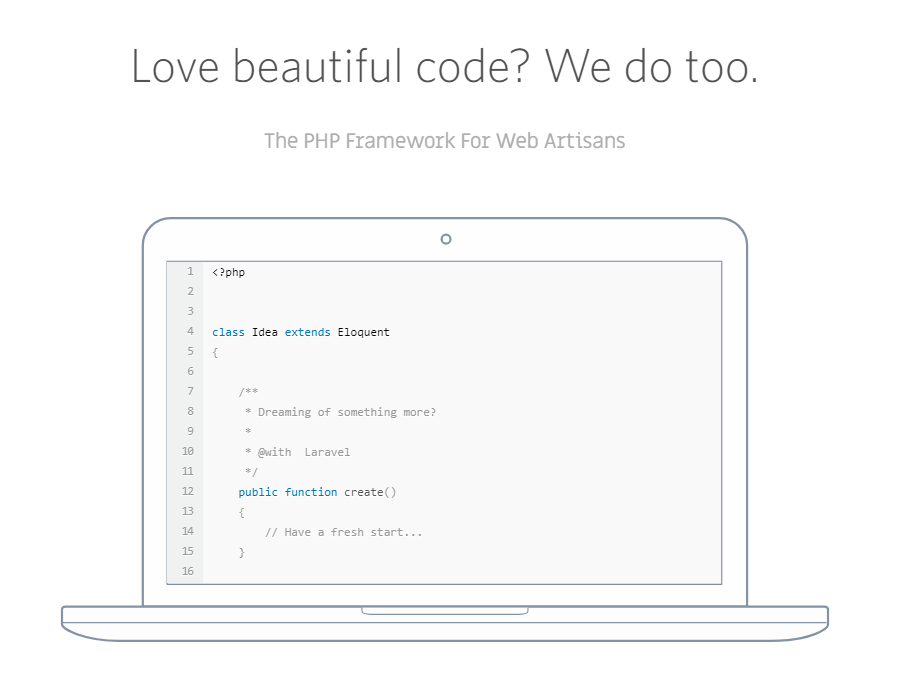
Laravel is released in 2011 and, it is regarded as the most accepted framework among clients and developers. As per the survey conducted by the SitePoint, Laravel is the most loved framework flagged by the web developers.
It has a massive ecosystem with an instantaneous hosting and deployment platform. It also has an official website that provides many screencast tutorials also known as Laracasts.
Laravel has many characteristics that make swift application development likely. It has its own light-weight templating engine which is called “Blade”. It comes with a highly elegant syntax that enables tasks you often require like authentication, queuing, sessions, caching and the RESTful routing. Laravel also comprises of a local development environment known as Homestead that comes as a packaged Vagrant box.
Key Features of laravel:
- Automatic Pagination: The automatic pagination feature in laravel PHP framework takes care of the overall settings.
- Routing Systems: Laravel PHP framework provides a reference to the laravel developer to select which route to trigger on the app. Routes in Laravel PHP framework are defined in the app, HTTP, routes or PHP file. The file is automatedly uploaded by the Laravel Framework. The route defining methodology is simple and expressing that acknowledges a URL and a closure. The user just has to put in the name of the route and the right URL will be automatedly inserted.
- Unit Testing: Code testing is made easier by Laravel PHP framework with the artisan command line Utility. Utilizing this functionality and feature, developers can effortlessly write their unit tests.
- Template Engine: Build stunning layouts using lightweight Laravel Templates with dynamic content seeding. CSS and JS Code structural widgets are also there to help out.
- Eloquent ORM: ORM stands for Object-relational mapping which is quicker than the other PHP Frameworks.
- Libraries: Pre-installed Object Oriented libraries are only accessible in Laravel and in no other PHP Frameworks. The authentication library is trouble-free to implement, and it also has features such as Cross-site Request Forgery protection, checking the active users, Bcrypt hashing, encryption as well as the password reset.
- Modular: The twenty diverse libraries on which Laravel is based on are alienated into detaching modules that allow the laravel developers to create responsive, modular and useful web apps.
Benefits of Laravel:
- Intuitive syntax settings set aside a lot of time
- Simple setup and customization processes
- Security provided by its pre-installed tools deliver protection from damaging injections
- The feature of keeping all the SQL codes in a diverse modal file eases the maintenance and code monitoring
- Laravel cashier, socialite, eloquent, elixir etc. ease the overall development process
-
CodeIgniter

CodeIgniter is one of the highly used lightweight PHP framework. It comes with a quite straightforward installation process that needs only a minimal configuration, so it can save you from a lot of issues.
It is also a perfect choice if you want to keep away from PHP version conflict, as it works adequately on almost all the shared and dedicated hosting platforms.
Codeigniter is known for its forum community which helps developers to suggest a solution and ask questions.
CodeIgniter is not firmly based on the MVC development pattern. Using Controller classes with CodeIgniter is a must, but Models and Views are not obligatory, and you can utilize your own coding and naming conventions. It is a lean framework comes as 2MB and enables you to add 3rd party plugins if you require more complex functionalities.
Key Features of CodeIgniter:
- Free to use: It is licensed under MIT license, which is why it is free to utilize.
- Follows MVC Pattern: It utilizes Model-View-Controller which essentially divides logic and presentation components. The request comes to the controller, database action is performed via model and output is showcased by views. However, in usual PHP scripting, each page corresponds to MVC which increases complexity.
- Lightweight: It is enormously light-weighted. Its core system needs very small library; other libraries may be additional which are added upon dynamic request as per your needs. That is why it is relatively swift and light weighted.
- SEO friendly URLs: URLs built by CodeIgniter are search-engine friendly and fresh. It utilizes a segment based approach rather than a benchmark query based approach.
- Built-in libraries: It comes with complete packet libraries that allow all the web needed tasks like a database, form validation, sending email, manipulating images and sending emails.
Benefits of CodeIgniter:
- It is swift, consistent, lightweight and more able than other platforms
- It is straightforward in debugging, has precise functions with outstanding performance as well as presentation
- It has an easy way to utilize modular programs and is compatible with most web servers, numerous operating systems, and platforms
- It has a strong community and one can find an enormous amount of support through forums and blogs
- It is popular amongst developers because of the effort investment
-
Symfony
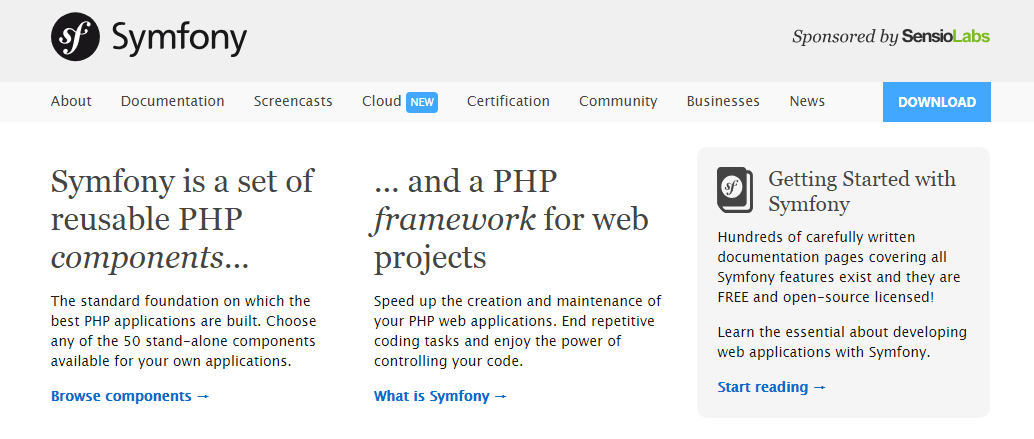
Symfony has an extensive developer community and many passionate fans. The elements of the Symfony 2 framework are utilized by multiple imposing projects. Symfony Components are reusable PHP libraries that you can work with diverse tasks with. It includes form creation, object configuration, templating, routing, authentication, and many others.
You can install any of the elements with the Composer PHP dependency manager. The site of Symfony has a cool display section where you can take a glance at its projects successfully executed with the help of this versatile framework.
Key Features of Symfony:
- Straightforward to install and configure on most of the platforms
- It is independent of the database engine and has simple usage
- Is flexible enough to become accustomed to compound cases
- It is based on the premise of convention above configuration
- The developer requires to configure only the original
- Compliant with mainly all web best design patterns and practices
- Adaptable to present IT policies, architectures and stable for long-term projects
- Readable code, with PHP Documentor comments and easy maintenance
- Easy to scale and allows integration with other vendor libraries
Benefits of Symfony:
- Swift development: You can save 2 or 3 days of work when reusing common components that go out-of-box. The saved time can be devoted to developing explicit features.
- Easier maintainability: Using a framework enforces structural and frequent rules to follow. Thus, it won’t be difficult for a new developer or team to join the in-progress project.
- Fewer problems and issues. The framework code is clear and demonstrated which decreases the mistakes.
- Enhanced security: The framework elements are backed with timely upgrades and enrichment of security.
-
Yii 2

If you pick the Yii framework you give a positive push to the performance of your website as it’s swifter than other PHP frameworks, as it broadly uses the lazy loading technique. Yii 2 is entirely object-oriented, and it works on the DRY (Don’t Repeat Yourself) coding concept, so it enables you with an appealing clean and highly logical code base.
Yii 2 is incorporated with jQuery, and it comes with a set of AJAX-enabled functionality, and it implements a simple to use skinning and theming method, so it can be a top option for someone who comes from a technically rich frontend background. It has also a commanding class code generator known as Gii that facilitates object-oriented programming, rapid prototyping and provides a web-based interface that allows you to interactively create the code you require.
Key Features of Yii 2:
- Yii assists you to create a more safe application by using features of a security application component.
- It handles OOP framework and leverages PHP’s modernized features like static binding, SPL classes, interfaces, and anonymous functions.
- Yii installation is handled by the composer which makes it very straightforward to install.
- Yii’s all cache elements are extended from Yii/caching/Cache, which grants the needed cache system when a common API is used.
- It is generally the most commonly used crud system and has features that avoid repetitive coding and needless jquery validations.
Benefits of Yii 2:
- Shorten the overall development time
- Highly extensible and utilizes advanced technologies
- Straightforward installation and manages errors effectively
- High on security and growth-friendly
- Offers intense acceleration for performance
- Simple to build application all along in the testing
-
Phalcon
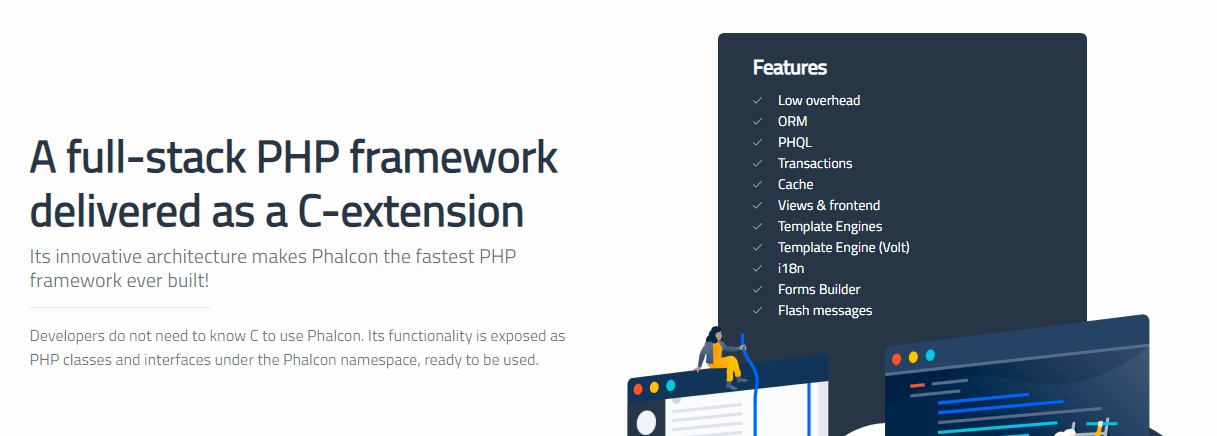
Phalcon is one of the top PHP frameworks in 2021, working on the model–view–controller (MVC) pattern. It was released in 2012, as an open-source framework licensed by the BSD License.
Phalcon is executed and implemented as a web server extension right in Zephir and C, with the objective to increase execution speed, trim down resource usage, and manage more HTTP requests every second than other frameworks written in PHP.
Key Features of Phalcon
- Speed – It is the swiftest framework for PHP.
- Framework Types – It is primarily a full stack and open-source framework.
- Self-sufficient – It can create an independent and autonomous framework.
- Minimum Coding – It needs less amount of code for explicit task execution.
- ORM – It offers ORM (Object Relational Mapping), routing, templating engine and caching functionalities
- Loosely Coupled Framework – As it is a loosely coupled framework, the users can develop the projects with a precise directory structure as per the app requirements
- Database Supported – It backs multiple databases like MySQL, SQLite, Oracle, Microsoft Bl, MongoDB, PostgreSQL, MariaDB, and MemcacheDB
Benefits of Phalcon
- High performance, Superior functionality and capable of high load
- Needs a minimum of file-based operations
- Consumes fewer resources
- You can utilize your personal base and its individual components
- The ORM technology engages with databases bringing in better performance
-
CakePHP
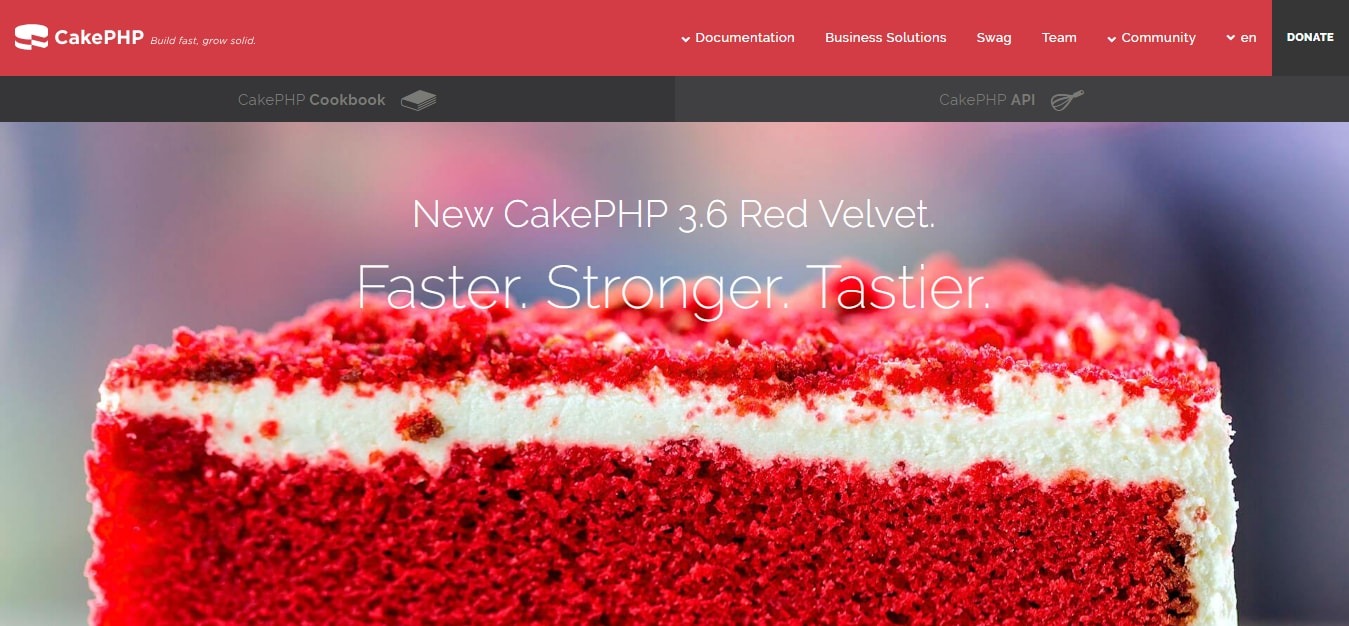
CakePHP is by now a decade old technology; however, it’s still amongst the majority of key PHP frameworks, as it has always handled to keep up with time. The installation process of CakePHP is easy and simple.
CakePHP core team announced the new latest verison 3.6.13 which provides a number of improvements which you can see below.
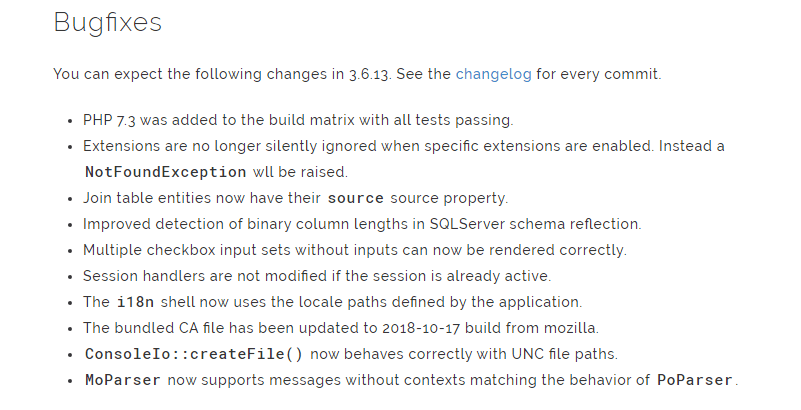
Also check here what you can get in the CakePHP 3.6.0.
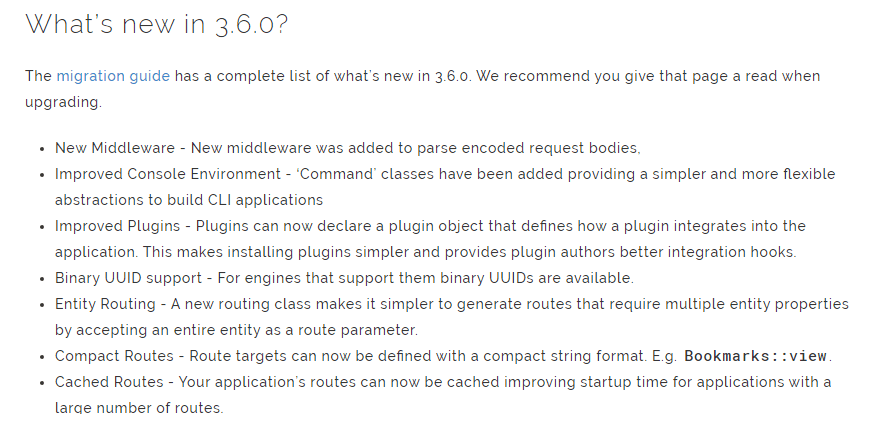
CakePHP has a really notable showcase; it empowers the web portals of big brands such as Hyundai, BMW, and Express. It is an exceptional tool for building web applications that require high-level of security, as it has several built-in security functionalities and features such as input validation, SQL injection prevention, XSS prevention, CSRF protection, and many other software tools.
Key Features of CakePHP
- CakePHP is based on MVC that assists in saving the queries to the database
- If you want to make some alteration in the database, then this framework will assist you to insert, delete, or alter the model with no difficulty
- It is licensed under the MIT and is available for free
- It is rapid in processing that can be utilized to develop amazing web applications
- It has inbuilt support for PSR-2 and PSR-4, localization and internationalization
- It provides data validation features that make it highly supple
- With the assistance of numerous built-in tools such as SQL injection prevention, CSRF protection, and input validation; it is measured as an authorized tool
Benefits of CakePHP
- It is easy to understand and work with CakePHP
- You don’t require being an expert to manage this platform
- It is highly secure, quick and flexible in usage
- Most intuitive framework and best for maintaining a very big project
- On-boarding, a new project team member, is very easier
- Promotes maintainability, reusability, testability and quick time to market
-
FuelPHP

FuelPHP, released in 2011, is a Model-View-Controller framework shaped from the ground up to have complete support for HMVC as an important and integral part of its architecture. Further, being amongst the most popular PHP frameworks, ViewModels were added into the mix, which offers you the choice to add a strong layer amid the Controller and the View.
It offers:
- End-to-End HMVC implementation
- ViewModels to have view-specific logic from Views and Controllers
- Route straight to closures
Key Features of FuelPHP
- Absolute Flexibility – There are incredibly a small number of restrictions on coding. The classes are flexible with any file structures, declaration of any folder as a “modules” folder is natural and native classes can be simply extended.
- Community Enthusiasm – It is a vast community-driven framework utilized for web development. Libraries and steady modifications have assisted the framework successfully move forward. Its structure assists in building core, modules, and packages quickly.
- Built-in Modular Structure – This is the feature of why this framework is so well-liked by the developers. Fuel implements the processes thoroughly well documented and simple to be integrated. Once applications are developed in a modular structure, it turns simpler for developers with needed benefits.
- ORM in the Core – This package gave an opening for one module in the new application and ended up utilizing it for all modules. It maps a model to every table in the database, enables the table’s fields, and their relevant relationships to other tables. FuelPHP is extendible with a built-in module and package hold.
Benefits of FuelPHP
- It extends its security approach ahead of regular security measures
- Assists in delivering inclusive web solutions that are different in size and complexities
- Has incredible structure in a tailored version of CodeIgniter and has benefits of PHP 5 version
- It consumes less memory and time offering enhanced performance
-
Slim
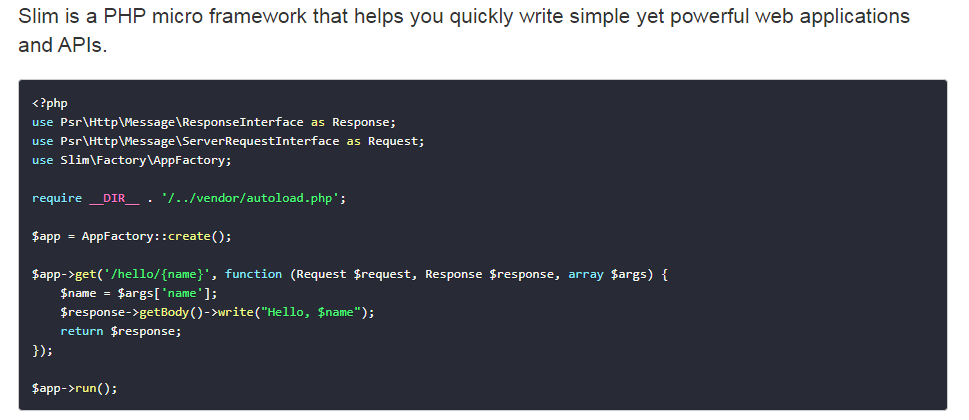
The slim framework is a forerunner of the micro-framework group taken place in 2013 and is still one of the most accepted frameworks today. It being the best PHP framework for your development comes with many helpful features devoted to assisting Slim developers, also in the most challenging scenarios. And this makes it to the List of PHP Frameworks in 2021.
Key Features of Slim
-
- Slack Integration
Slack is a web messaging software for enabling interactions in teams. With the latest expansion of freelance culture and every day increasing number of virtual companies, Slack turns one of the most utilized tools globally.
-
- HTTP Router
It has a swift and influential router that maps route call backs to precise HTTP request methodologies and URIs. Slim backs both parameters as well as pattern matching. Moreover, Slim’s routing enables and facilitates developers to build SEO optimized URLs.
-
- Middleware
Developing apps with middleware, helps in tweaking the HTTP requests and response objects across the Slim application. This scenario assists in protecting applications for cross-site requests and validates requests previous to running apps.
-
- PSR-7 Support
Backs any of the PSR-7 HTTP message implementations and offer complete flexibility.
-
- Dependency Injection
Allows complete control over exterior tools, and to utilize any of the container-Interop containers.
-
- Generate REST Applications
Slim helps build a REST API, which turns it trouble-free for developers to enable 3rd party access to app functions.
-
- HTTP Caching
It helps to keep assets which do not regularly alter, such as favicon, CSS files, and static.
Benefits of Slim
- Enhances a website’s performance and load time
- Routing facilitates HTTP verbs such as “Update” “Delete,” “Post” and “Get” which enables to generate SEO optimized URLs
- Developers can easily replace default objects with 3rd party implementations
- A professional community of users and fellow Slim developers are there to assist as well as share their know-how
-
Key Takeaways
Here, we discussed above best PHP frameworks and its comparisons that can most remarkably assist the progression of backend development. There are more than a few reasons a developer would want to opt for a framework. Most particularly as they provide a structured, competent fast-track towards developing web applications and makes easy to work with diverse APIs.
They make sure that code doesn’t have to be created more than once for frequent functionality such as security and authentication, database management, templating, URL handling, and other important requirements.









